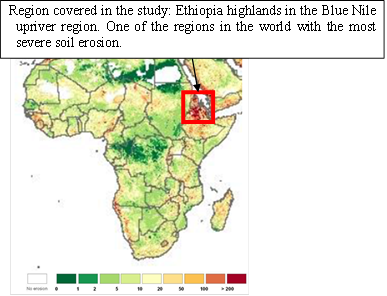Background of the Research
Soil erosion in Ethiopia and damage caused by it
Degradation of natural resources such as soil, water, and vegetation is the biggest environment problem in Ethiopia. In particular, erosion caused by water in Ethiopia highlands that produce 90% of agricultural production is the most severe by the world standard (Figure 1). Because of water erosion, topsoil is lost at the rate of about 15 mm every year, and at this rate, the entire meaningful soil of Ethiopia highlands will be lost in approximately 100 years (FAO, 1998).
Soil erosion can be divided the onsite problem and the offsite problem. Onsite problem refers to a problem that occurs at the place where the erosion occurs, and soil erosion leads to erosion of the surface soil lowering the soil fertility and reduction of soil water retention capacity. This results into decline in land productivity and reduced crop yield, in the worst cases cultivation itself will become impossible. On the other hand, offsite problem is the effect of eroded soil on the downstream region through rivers, where dams and reservoirs get buried with soil causing floods or water pollution in rivers and lakes.
What is SLM (Sustainable Land Management)?
For dealing with desertification and land degradation in arid regions, in recent years, a project called “Sustainable Land Management” is extensively implemented all over the world. Sustainable Land Management (SLM) is a concept that includes technologies and mechanisms for sustainable land production through appropriate soil and water management, maintenance of livelihood, and conservation of environment.
In Ethiopia, it is common to implement SLM as a soil and water conservation project. In specific terms, trench ( ditch for trapping running water), soil bund or stone bund (each dike or stone masonry along the contour), checkdams across gullies, tree plantation in degraded hills etc. is done.
The features of the next generation SLM to be developed in this research. In the next generation SLM, we aim to achieve high level soil erosion reduction benefits, sustainability, autonomy, and comprehensiveness.
